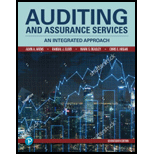
EBK AUDITING+ASSURANCE SERVICES
17th Edition
ISBN: 9780135171219
Author: ARENS
Publisher: PEARSON CO
expand_more
expand_more
format_list_bulleted
Question
Chapter 17, Problem 27DQP
To determine
Determine the appropriate response for each of the sampling results from the options
Expert Solution & Answer
Want to see the full answer?
Check out a sample textbook solution
Students have asked these similar questions
What is the cost per equivalent unit for direct materials for March
Can you help me solve this general accounting question using the correct accounting procedures?
A company carries an average annualinventory of $8.3 million if it estimates the cost of capital is 11% so much costs are 7% and risk calls are 12%. What does it cost per year to carry this inventory?
Chapter 17 Solutions
EBK AUDITING+ASSURANCE SERVICES
Ch. 17 - Prob. 1RQCh. 17 - Prob. 2RQCh. 17 - Prob. 3RQCh. 17 - Prob. 4RQCh. 17 - Prob. 5RQCh. 17 - Prob. 6RQCh. 17 - Prob. 7RQCh. 17 - Prob. 8RQCh. 17 - Prob. 9RQCh. 17 - Prob. 10RQ
Ch. 17 - Prob. 11RQCh. 17 - Prob. 12RQCh. 17 - Prob. 13RQCh. 17 - Prob. 14RQCh. 17 - Prob. 15RQCh. 17 - Prob. 16RQCh. 17 - Prob. 17RQCh. 17 - Prob. 18RQCh. 17 - Prob. 19RQCh. 17 - Prob. 20RQCh. 17 - Prob. 21.1MCQCh. 17 - Prob. 21.2MCQCh. 17 - Prob. 21.3MCQCh. 17 - Prob. 22.1MCQCh. 17 - Prob. 22.2MCQCh. 17 - Prob. 22.3MCQCh. 17 - Prob. 23.1MCQCh. 17 - Prob. 23.2MCQCh. 17 - Prob. 23.3MCQCh. 17 - Prob. 24.1MCQCh. 17 - Prob. 24.2MCQCh. 17 - Prob. 24.3MCQCh. 17 - Prob. 25DQPCh. 17 - Prob. 26DQPCh. 17 - Prob. 27DQPCh. 17 - Prob. 28DQPCh. 17 - Prob. 29DQPCh. 17 - Prob. 30DQPCh. 17 - Prob. 31DQPCh. 17 - Prob. 32DQPCh. 17 - Prob. 34DQPCh. 17 - Prob. 35DQP
Knowledge Booster
Similar questions
- SUBJECT: FINANCIAL ACCOUNTINGarrow_forwardGeneral Accounting Question please answerarrow_forwardA company carries an average annual inventory of $8.3 million if it estimates the cost of capital is 11% so much costs are 7% and risk calls are 12%. What does it cost per year to carry this inventory?arrow_forward
arrow_back_ios
SEE MORE QUESTIONS
arrow_forward_ios
Recommended textbooks for you
 Auditing: A Risk Based-Approach (MindTap Course L...AccountingISBN:9781337619455Author:Karla M Johnstone, Audrey A. Gramling, Larry E. RittenbergPublisher:Cengage Learning
Auditing: A Risk Based-Approach (MindTap Course L...AccountingISBN:9781337619455Author:Karla M Johnstone, Audrey A. Gramling, Larry E. RittenbergPublisher:Cengage Learning Essentials of Business Analytics (MindTap Course ...StatisticsISBN:9781305627734Author:Jeffrey D. Camm, James J. Cochran, Michael J. Fry, Jeffrey W. Ohlmann, David R. AndersonPublisher:Cengage Learning
Essentials of Business Analytics (MindTap Course ...StatisticsISBN:9781305627734Author:Jeffrey D. Camm, James J. Cochran, Michael J. Fry, Jeffrey W. Ohlmann, David R. AndersonPublisher:Cengage Learning Auditing: A Risk Based-Approach to Conducting a Q...AccountingISBN:9781305080577Author:Karla M Johnstone, Audrey A. Gramling, Larry E. RittenbergPublisher:South-Western College Pub
Auditing: A Risk Based-Approach to Conducting a Q...AccountingISBN:9781305080577Author:Karla M Johnstone, Audrey A. Gramling, Larry E. RittenbergPublisher:South-Western College Pub

Auditing: A Risk Based-Approach (MindTap Course L...
Accounting
ISBN:9781337619455
Author:Karla M Johnstone, Audrey A. Gramling, Larry E. Rittenberg
Publisher:Cengage Learning

Essentials of Business Analytics (MindTap Course ...
Statistics
ISBN:9781305627734
Author:Jeffrey D. Camm, James J. Cochran, Michael J. Fry, Jeffrey W. Ohlmann, David R. Anderson
Publisher:Cengage Learning

Auditing: A Risk Based-Approach to Conducting a Q...
Accounting
ISBN:9781305080577
Author:Karla M Johnstone, Audrey A. Gramling, Larry E. Rittenberg
Publisher:South-Western College Pub